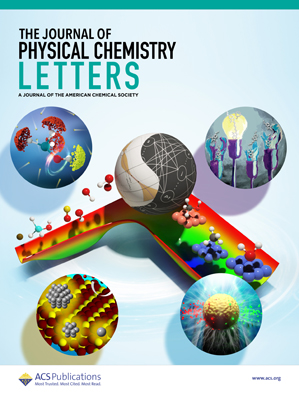基于纯空穴注入机制的高性能量子点近红外上转换器件
IF 4.6
2区 化学
Q2 CHEMISTRY, PHYSICAL
引用次数: 0
摘要
胶体量子点(CQD)近红外(NIR)上转换器件(ucd)可以直接将低能量的近红外光转换为高能量的可见光,而无需额外的集成电路,这对近红外传感和成像是有利的。然而,最先进的CQD近红外上转换器仍然面临挑战,包括高导通电压(Von)、低光子对光子(p-p)上转换效率和低电流开/关比,主要是由于器件结构和操作机制的固有限制。在这项工作中,我们开发了一种基于孔内注入机制的CQD近红外UCD。我们的装置有效地抑制了阴极的电子注入,而不阻碍阳极的空穴注入。因此,器件的暗电流降低到一个较低的水平,这有利于光生载流子和注入电荷的平衡。此外,我们采用液相配体交换工艺处理PbS CQD光敏层(PSL),提高了PSL的均匀性和电荷输运能力,进一步优化了光生载流子的利用。我们为CQD NIR UCD实现了创纪录的高电流通/关比,超过3.5 × 105。此外,该器件还具有12.8%的p-p上转换效率和1.8 V的低Von。本文章由计算机程序翻译,如有差异,请以英文原文为准。

High-Performance Quantum Dot Near-Infrared Upconversion Devices Based on the Hole-Only Injection Mechanidsm
Colloidal quantum dot (CQD) near-infrared (NIR) upconversion devices (UCDs) can directly convert low-energy NIR light into higher energy visible light without the need for additional integrated circuits, which is advantageous for NIR sensing and imaging. However, the state-of-the-art CQD NIR upconverters still face challenges, including high turn-on voltage (Von), low photon-to-photon (p–p) upconversion efficiency, and low current on/off ratio, primarily due to inherent limitations in the device structure and operating mechanisms. In this work, we developed a CQD NIR UCD based on a hole-only injection mechanism. Our device effectively suppresses electron injection from the cathode without hindering hole injection from the anode. As a result, the dark current of the device is reduced to a low level, which is favorable for the balance of photogenerated carriers and injected charges. Furthermore, we employed a liquid-phase ligand-exchange process to treat the PbS CQD photosensitive layer (PSL), which enhances the uniformity and charge transport capability of PSL, further optimizing the utilization of photogenerated carriers. We achieved a record high current on/off ratio exceeding 3.5 × 105 for the CQD NIR UCD. Additionally, the device exhibits a high p–p upconversion efficiency of 12.8% and a low Von of 1.8 V.
求助全文
通过发布文献求助,成功后即可免费获取论文全文。
去求助
来源期刊

The Journal of Physical Chemistry Letters
CHEMISTRY, PHYSICAL-NANOSCIENCE & NANOTECHNOLOGY
CiteScore
9.60
自引率
7.00%
发文量
1519
审稿时长
1.6 months
期刊介绍:
The Journal of Physical Chemistry (JPC) Letters is devoted to reporting new and original experimental and theoretical basic research of interest to physical chemists, biophysical chemists, chemical physicists, physicists, material scientists, and engineers. An important criterion for acceptance is that the paper reports a significant scientific advance and/or physical insight such that rapid publication is essential. Two issues of JPC Letters are published each month.
 求助内容:
求助内容: 应助结果提醒方式:
应助结果提醒方式:


